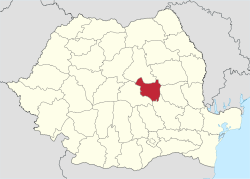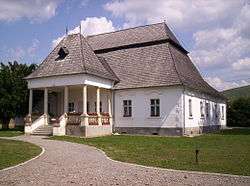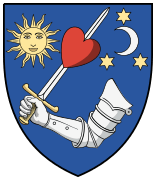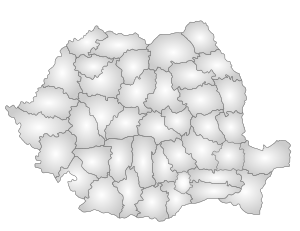Covasna County
| Covasna County Județul Covasna Kovászna megye | ||
|---|---|---|
| County | ||
|
Landscape in the northern part of Covasna County | ||
| ||
 | ||
| Coordinates: 45°54′N 26°02′E / 45.9°N 26.03°ECoordinates: 45°54′N 26°02′E / 45.9°N 26.03°E | ||
| Country |
| |
| Development region1 | Centru | |
| Historic region | Transylvania | |
| Capital city (Reședință de județ) | Sfântu Gheorghe | |
| Government | ||
| • Type | County Board | |
| • President of the County Board | János Demeter (UDMR) | |
| • Prefect2 | Ervin György | |
| Area | ||
| • Total | 3,710 km2 (1,430 sq mi) | |
| Area rank | 39th in Romania | |
| Population (2011) | ||
| • Total | 206,261 [1] | |
| • Rank | 42nd in Romania | |
| • Density | 60/km2 (200/sq mi) | |
| Time zone | EET (UTC+2) | |
| • Summer (DST) | EEST (UTC+3) | |
| Postal Code | 52wxyz3 | |
| Area code(s) | +40 x674 | |
| Car Plates | CV5 | |
| GDP | US$ 2.1 billion (2008) | |
| GDP/capita | US$ 9,461 (2008) | |
| Website |
County Board County Prefecture | |
|
1The developing regions of Romania have no administrative role. 2 as of 2007, the Prefect is not a politician, but a public functionary. He (or she) is not allowed to be a member of a political party, and is banned to have any political activity in the first six months after the resignation (or exclusion) from the public functionary corps 3w, x, y, and z are digits that indicate the city, the street, part of the street, or even the building of the address 4x is a digit indicating the operator: 2 for the former national operator, Romtelecom, and 3 for the other ground telephone networks 5used on both the plates of the vehicles that operate only in the county limits (like utility vehicles, ATVs, etc.), and the ones used outside the county | ||
Covasna (Romanian pronunciation: [koˈvasna], Hungarian: Kovászna, Hungarian pronunciation: [ˈkovaːsnɒ]) is a county (județ) of Romania, in Transylvania, with the capital city at Sfântu Gheorghe.
Demographics
In 2011, it had a population of 206,261, making it the least populous of Romania's 41 counties and the population density was 55.6/km².
In 2002 the ethnic composition of the county was as follows:
- Hungarians – 73.58% (or 164,158)[2]
- Romanians – 23.28% (or 51,790)
- Romani – 2.68% (or 5,973)
According to the 2011 census, the composition of the county was:
- Hungarians – 73.74% (or 150,468)[3]
- Romanians – 22.02% (or 45,021)
- Romani – 4.05% (or 8,267)
- others - 0.19%
Covasna County has the second-greatest percentage of Hungarian population in Romania, just behind the neighboring county of Harghita. The Hungarians of Covasna are primarily Székelys.
| Year | County population[4] |
|---|---|
| 1948 | |
| 1956 | |
| 1966 | |
| 1977 | |
| 1992 | |
| 2002 | |
| 2011 |
Geography
Covasna county has a total area of 3,710 km².
The main part of the relief consists of mountains from the Eastern Carpathians group. Most localities can be found in the valleys and depressions located along the different rivers crossing the county. The main river is the Olt River; along its banks lies the capital city Sfântu Gheorghe.
Neighbours
- Vrancea County and Bacău County in the East.
- Brașov County in the West.
- Harghita County in the North.
- Buzău County in the South.
Economy
Covasna county’s Industry’s main sectors are food industry (33.79%), ready-made garment and textile (21.93%), wood and wooden products (14.98%), metals, machines and automotive suppliers (10.31%), building materials (9.68%). Other sectors of industry are chemicals (4.67%), toys (2.02%), water (1.09%), printing (0.45%), energy (0.13%), jewelry (0.05%), other industrial activities (0.83%).
Industry in Covasna county’s economy is representing 42.53%. Other main sectors are Trade with 30.98%, Services 11.38%, Agriculture 9.71%, Construction 5.78%, R&D and High-Tech 2.63%,
Companies from Covasna county’s Industry produced in 2014 almost half billion EUR (477 199 849 EUR) turnover, with a staggering 10.78% increase in volume compared to the preceding year’s income.
One of Covasna county’s main industrial sectors is ready-made garment industry, where processing companies are owned by German investors, who started to establish first brown-field investments in 1992, and since then they operate 9 factories producing yearly 5 million trousers for brands like Bosch, Meyer, Wegener. Other privately owned companies in the field of textiles, producing different articles, some of them have their own brand, while the others work in lohn systems.
In 2015 started the Schweighoffer Holzindustrie after investing 150 million EUR in a new plant for primary wood processing. With the rich forested areas, Covasna has a long tradition of sawn timber export and production of furniture and other finished wooden products. Recently created the ProWood Cluster in the interest of the industry.
A few years ago automotive industry suppliers were established, with two new plants producing steering wheels and electric circuits for vehicles. The automotive industry suppliers from Covasna and neighboring Braşov are offers a vast pallet of competitive products, from boards for Mercedes cars to Airbus helicopters, while having a good potential for growth. Nevertheless, is important to mention Poliprod, the French owned family business of Champrenaut Group involved in steel work, locksmithery, welding, machining or the major producer of electric ceramic heaters in Eastern Europe, member of the Canadian Delta Group. This industry can build up its workforce with new students from the large technical university in Brasov.
Covalact is a nationwide well-known dairy product brand, now owned by Dutch investors. Another milk processing plant under brand Olympus, with Greek investors, establishing it’s HQ in the county.
Other examples of food - meat processing companies are the Bertis and Toro Impex, who are regionally active players, while the Norvegian Orkla food producing network has a meat canning plant in Covasna.
Dunapack, a member of the Austrian Prizhorn, supplies corrugated cardboard boxes to almost all industry branches, from FMCG to fruit, vegetable and electronics.
While IT&C as an industry sector is in emerging state, Covasna county’s Strategy for Development plans to use this field of activity as one pillar for development. Many new start-ups are in the area successful deploying large projects for sound international companies. A large number of young technicians arrive from universities.
Agriculture represents 4.83% of Covasna county’s economy, mainly producing varieties of potatoes, several companies being able to supply selected and packaged crops for hyper-markets. Other agricultural products are rapeseed, grains, cabbage.
Covasna county, with a large number of mineral water springs, have developed during history a network of spas for treating different health problems, mainly cardio-vascular. There is a good potential for development of this field of health and spa tourism.
Tourism


The main tourist destinations in the county are:
- The city of Sfântu Gheorghe
- The resorts in the mountains around:
- Covasna
- Balványos
- Malnaş-Băi
- Vâlcele
- Șugaș-Băi
- Baile Fortyogo
- Biborțeni
- Ozunca-Bai
- The mountains:
- Baraolt Mountains
- Bodoc Mountains
- Nemira Mountains
- Întorsurii Mountains
Politics
The Covasna County Council, elected at the 2016 local government elections, is made up of 31 counselors, with the following party composition:[5]
| Party | Seats | Current County Council | ||||||||||||||||||||
|---|---|---|---|---|---|---|---|---|---|---|---|---|---|---|---|---|---|---|---|---|---|---|
| Democratic Alliance of Hungarians | 20 | |||||||||||||||||||||
| National Liberal Party | 3 | |||||||||||||||||||||
| Social Democratic Party | 3 | |||||||||||||||||||||
| Hungarian People's Party of Transylvania | 3 | |||||||||||||||||||||
| Hungarian Civic Party | 2 | |||||||||||||||||||||
Administrative divisions

Covasna County has 2 municipalities, 3 towns and 40 communes.
- Municipalities
- Sfântu Gheorghe – capital city; population: 54,312 (as of 2011)
- Târgu Secuiesc
- Towns
References
| Wikimedia Commons has media related to Covasna County. |
- ↑ http://www.covasna.insse.ro/phpfiles/DATE_PROVIZORII_RPL-2011_CV.pdf
- ↑ National Institute of Statistics, "Populaţia după etnie" Archived 16 August 2009 at the Wayback Machine.
- ↑ Recensamantul Populatiei si Locuintelor 2011: Populația stabilă după etnie – județe, municipii, orașe, comune
- ↑ National Institute of Statistics, "Populația la recensămintele din anii 1948, 1956, 1966, 1977, 1992 și 2002" Archived 22 September 2006 at the Wayback Machine.
- ↑ "Mandate de CJ pe judete si competitori" (in Romanian). Biroul Electoral Central. 10 June 2016. Retrieved 16 June 2016.
External links
- www.covasna.ro – site of Covasna



_from_Agostonfalva.jpg)